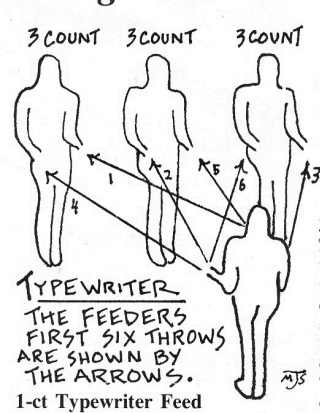 |
 |
Page 38 Fall 1988
|
TIPS
& TRICKS Advanced
Club Passing Patterns by
Martin Frost
In
order to concisely describe passing sequences that include passes from
both right and left hands, we'll use the count notation. A
count is a throw from either hand. In most juggling, the right and
left hands alternate throwing, and we call each such throw a count.
In
the count system, we specify the number of counts per pass. Thus in a
2-count (or 2-ct) passing pattern, you pass on every other count. This
means every throw from one hand is a pass to your partner. The other
of the two counts is a self throw with the other hand.
In
a 4-ct, every other throw from one hand (every fourth count) is a
pass. Of course, you can have a left-handed 2-ct, where you pass every
left hand. (An early appearance of the count notation is in Richard
Dingman's book on passing, Patterns.)
Now,
an interesting pattern, and one that has caught on a lot in the last
few years, is the 3-ct (called "onesies" by some people).
Here, you pass on every third count, which means alternate passing
with the right and left hands.
With
the 3-ct pattern as a basis, we'll build two interesting feeds: the
3-ct feed and the 1-ct typewriter feed. In each of these patterns, the
feedees are doing a normal 3-ct, but the feeder is passing more often.
3-ct Feed
3p9c
(3 people, 9 clubs). Each of the two feedees in this pattern does a
normal 3-ct with the feeder. One feedee starts immediately with a R
pass and the second feedee starts with a R self throw followed by a L
pass. Thereafter each feedee passes every third count (alternating R
and L). The feeder throws two passes (R then L, one to each feedee),
then a self R, then two passes (L then R, one to each feedee), and
then a self L, before repeating.
An
easy way to remember the feeder's pattern is to notice that it is two inside
passes (R&L), a self, then two outside passes
(L&R), and then a self. The first of each pair, of consecutive
passes always goes to the same person, say to the person on the left
(who starts the pattern with a R pass). The second of each pair always
goes to the other person.
1-ct Typewriter Feed
4p12c.
This is like the 3-ct feed, but we add a third feedee to get a pass
from the feeder on the third count (replacing the feeder's one
remaining self). So the feeder here does no self passes at all,
passing every club from both hands and going down the row of three
people, passing one club to each person in turn (alternating passing
hands). After the pass to the third person in the row, the next pass
goes back to the first person, on the other end - hence the name
"typewriter" feed.
Each
feedee does a normal 3-ct, but the feeder is doing a 1-ct. The
challenging part is for the feeder to figure out where the next pass
should go - especially if someone drops a club!
Hourglass 6p18c.
This is an active, but not too difficult pattern for six people whose
positions form an hourglass shape. This formation appears in the
Winter 1986 Juggler's World (p. 21), but here we add some
interesting passing sequences for it.
Two
people stand in the middle facing each other, but each feeds two
people behind the other middle person. If one feeder starts with the
person on the left and the other feeder starts with the person on the
right, then the feeds cross like a box, and the two outside people who
are not being fed at any given count can pass to each other. Thus
everyone ends up feeding two people.
The
middle feeders must watch out for their passing and catching hands as
other clubs cross by them, making it visually (if not physically)
striking. All six people have
the same passing sequence, but it can be any sort of sequence.
Try
a simple right handed 2-ct or a simpler 4-ct, or pass with both hands
using a plain 3-ct, a more complex 3-ct feed (using the 3-ct feeder's
sequence of passpass-self), or even a 1-ct. With a 1-ct, everybody
has one hand feeding one person and the other hand feeding the second
person. |
 |
 |